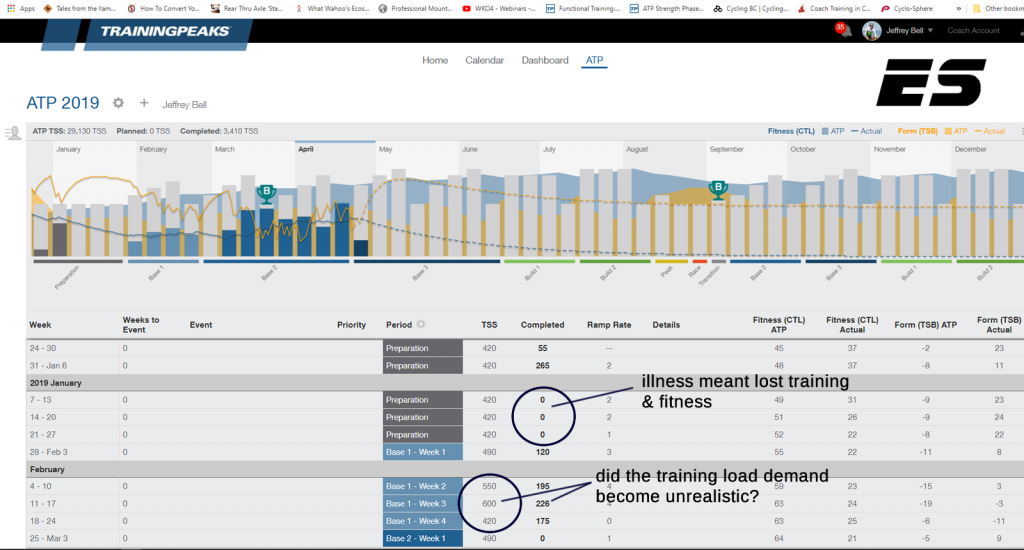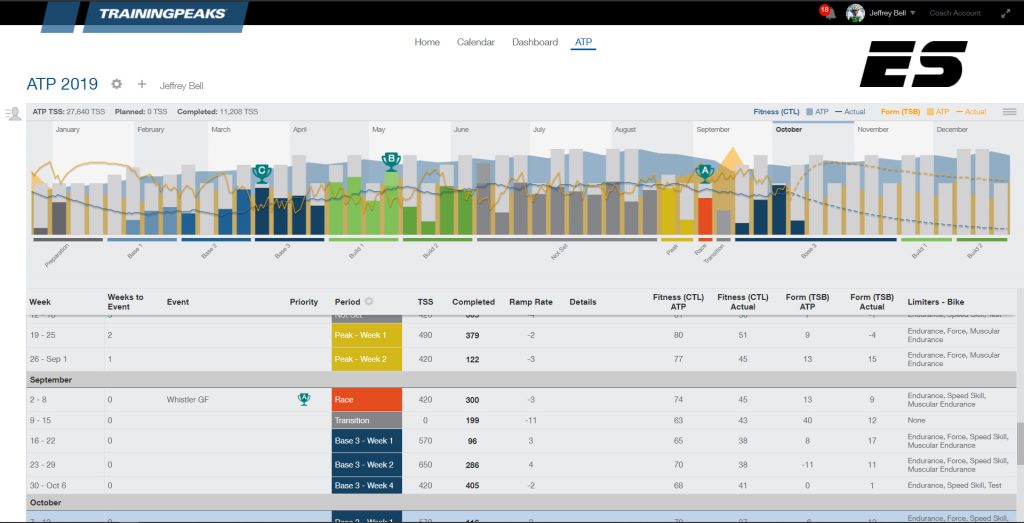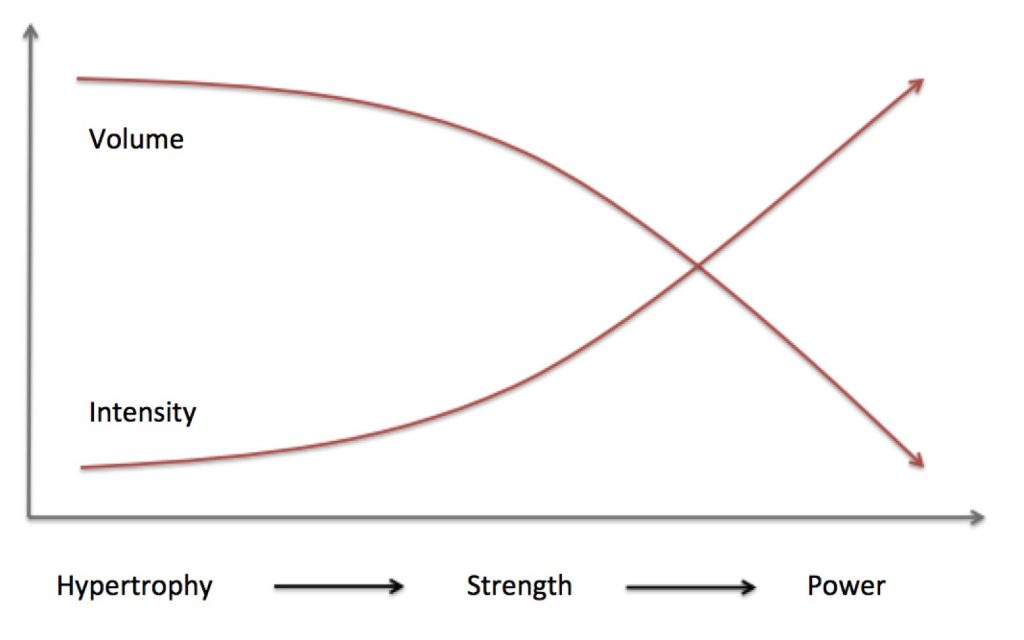Like a financial asset, the cycling athlete is constrained by one dominant influence – time.
Like a financial asset, the performance of a cycling athlete, is constrained by one dominant influence – time! Therefore, like a financial asset, maximizing the rate of return is critical to the success and ultimate rewards from the investment of training and racing. For the athlete, this rate of return is made up of long term fitness growth and ongoing training and competitive improvement and success. This is akin to capital growth and income flow that makes up the return from a financial asset or investment.
Taking this analogy a little further, any investment asset, be it real estate, stocks, lean hogs, or rare coins, requires periodic or constant valuation and performance measurement, thereby providing some ability to manage the assets changing environment and the risks and or gains to be mitigated or realized.
For the cycling athlete, the environment in which training, competition, and life takes place, which like the markets for financial or monetary assets, are defined by many external and internal process and variable demands which are part of that environment in which they dwell. As such both financial investments and the cycling athlete are prone to exogenous shocks and impacts that are out of the control of the participants.
However, there is one tool that both free market investment experts and cycling athlete’s can utilize – strategic planning in the form of a structured plan.
Most financial investment experts will understand that for financial success a financial plan is critical for the success of any financial investment strategy, as part of a means of managing risk and long term financial goals and success. For the athlete, it is the training plan which helps set the time based training and competitive parameters, goals, and the training structure that enables decision making and evaluation of performance and training. For the amateur cycling athlete the demands and constraints of everyday life, work, family and relationships, and finances, necessitate a training plan to have a tool in dealing with the unknown, and changing demands that will affect training and the returns from it. It is setup to typically cover one year or competitive seasons and is continually adjusted.

A training plan will at the very least help answer some basic questions about what training should be done and when it should be done, and provide context and the reasoning for undertaking a particular form of training at a point in your training calendar. Ultimately, a training plan will provide the means for making decisions about training and workouts, specific and general fitness of the athlete, and the level of preparedness and potential for success in competition.
A training plan will allow a coach or athlete to develop the necessary fitness, technical skills, and emotional state for competition and peak performance, while utilizing their training data and guided by effective training principles. This will increase the odds of reaping a positive return on their training investment.
A training plan when looked at season to season also provides a retrospective which enables more informed decisions about training and competing that help direct and manage long term goals over time. A few of the more typical questions might be:
- Will the training plan actually work with my schedule?
- What would happen if I increased/reduced the time I spend training?
- What would happen I f I increased or reduced intensity?
- Is my training plan too hard/easy for me?
- How do I get the best out of my training time?
- What training methodology will work best for me?
Periodize, periodize . . . periodize!
Periodization is the time management principle which permits the synchronization of training, changing fitness and performance over a time period – typically defined by specific cycles or blocks in a training year.
Using a training plan will allow for the periodization of training, the time management principle which permits the synchronization of training, changing fitness and performance over a time period – typically defined by specific cycles or blocks in a training year.
As a coach, or self-coached athlete, you must develop a system to manage short term (acute) and long term (chronic) fitness development such that performance and fitness will peak at the appropriate times of the year when competition or events are occurring. This is the fundamental purpose of an annual training plan (ATP). For a plan to be successful it will require identifying, and subsequently exploiting all of the athlete’s unique physiological resources and capacity over constrained time windows. Periodization will help enable such management.
The concept of training periodization is centered around organized blocks of time. These will be short micro and meso blocks, and longer macro blocks of training time that when combined together complete the interrelated components of the annual periodized training plan time line. Usually this periodized planning is goal driven, in other words, there are periodic targets that need to be identified, continually reassessed, and adjusted, while managing one or more ultimate longer term competition or performance goals.

Types of periodization
Three of the most common forms of periodization structure are known as blocked, undulating, and linear training plans. (See below). Although they all follow the basic macro-, meso-, and micro-cycle structure, each provides a niche emphasis on different training aspects depending on an athlete’s needs. The main training variables, namely, load, volume, intensity, and exercise type are varied in each type of periodization but with different emphasis and timing during the training plan.
Finally, with an annual training plan and using periodization, one of the first things that will change and be noticed by a lot of untrained riders is that your hard training days become harder and your easy days become easier. Most people who train without structure will ride at a medium-hard pace most of the time. They might ride a little easier if they don’t feel great or push a little harder to chase a fast group of friends, but for the most part, they’re riding in the middle of their ability range and comfort. You can get stronger and faster this way, but the peak of that fitness is lower than with a structured, periodized program. Riding medium-hard all the time means you will never get the big stimulus of completing a super hard workout with fresh legs, or the adaptation that comes with subsequent recovery.Periodization Components
So what about those cyclical components that make up the foundation of periodization? These are the macrocycles, mesocycles, and microcycles. The simple relationship of the building blocks of periodization are that one macrocycle is made up of multiple mesocycles, and one mesocycle is made up of multiple microcycles.
Macrocycles
The macrocycle is the longest of the three cycles and includes all four training development stages of a periodized training program (e.g. endurance, intensity, competition and recovery). Because macrocycles incorporate all 52 weeks of your annual training plan, they provide you with a bird’s-eye view of your training regime and allow you to facilitate long-range planning. For example, if you want to peak for a national championship event one year from now, you can mark that date in your calendar and work backward to create a program that allows you to peak at that time.
You can use the same process to identify several major events throughout the year and develop a plan that facilitates multiple fitness peaks. In a traditional plan, the macrocycle is often as short as 28 weeks. Throughout a macrocycle, you will see the progressive addition of training stimulus and the necessary recovery to drive aerobic adaptations.
Macrocycles need to include different phases that address base fitness and then drive towards more specific fitness. By following a logical pattern, each phase ultimately leads to a particular set of adaptations upon which peak fitness is balanced. These progressive phases are Base, Build, and Specialty and Competitive phases, with the Competitive phase culminating at the desired time period.
Mesocycles
Mesocycles are four to six-week blocks within the macrocycle and are typically referred to as blocks. In a typical four week block, the first three weeks progressively overload your body, while the fourth week focuses on recovery. Each new week within a mesocycle sees a slight increase in the overall amount of stress (TSS), while each workout sees a similar bump in the amount of work demanded. This is done by more or longer intervals.
The mesocycle represents a specific block of training that is designed to accomplish a particular goal. For instance, during the endurance phase , you might develop a mesocycle designed to enhance your muscular endurance on the bike (i.e. the ability to pedal relatively big gears, at a moderate cadence, for extended periods of time). This mesocycle might consist of six workouts over three weeks focused on pedaling big gears, with one week of recovery. Similarly, you could develop a mesocycle for the intensity phase that is designed to improve your functional threshold power (FTP) ( the highest average power you can sustain at a steady state effort for 35 to 50 minutes). This mesocycle might include three weeks of threshold intervals followed by a week of recovery.
Two very common mesocycles consist of 21-day and 28-day training blocks. For example, a 25 year-old experienced competitor might use a 23/5 training pattern (i.e., a 28 -day mesocycle). This pattern will consist of 23 days of relatively hard work followed by 5 days of recovery and easy spinning.
Conversely, an older or less experienced athlete may opt for a 16/5 ratio (i.e., a 21-day mesocycle) with 16 hard days of training followed by 5 days of recovery. If you have no direction from a coach or plan or are unsure about which mesocycle duration to use, then start with a 21 day or three week mesocycle and shift to a longer option such as a 28-day option when you are ready for a harder challenge. Finally, if you are currently using a 28-day mesocycle and are dealing with nagging or recurring fatigue, use a shorter mesocycle, which provides more time for recovery.
During the competition phase, you could develop a mesocycle that improves your neuromuscular power, which is the ability to pedal a very big gear, at a very high cadence, for a short burst of time of 12 to 15 seconds (i.e. sprinting). This mesocycle might include four long sprint interval workouts and four short sprint interval workouts over a three week period. During mesocycles with directed focus you will also want to work on skill or technique aspects related to the physiological development application, for example sprinting and developing good rhythm and balance out of the saddle and reducing inefficiencies from your pedal stroke or force development, and even practicing bike throws for sprint finishes.
A Mesocycle like this is leading to increased explosive power, but those sprints also improve reaction time for accelerations in the group to bridge small gaps and go with attacks. When you practice sprinting you’re practicing accelerations, and that has applications far beyond the final surge to the finish line.
Microcycles
A microcycle is the shortest training block within a periodized plan, typically lasting about 7 days and typically has a clearly defined goal of facilitating a focused block of training. Such an example, would be an endurance block with three to four long rides together within a week to progressively overload training volume. Another example, would be incorporating block training, which consists of very hard workouts for two or three consecutive days followed followed by an equal amount of recovery or days off. This would constitute an intensity microcycle where the goal is to improve key physiological abilities such as lactate threshold (the highest intensity a fit cyclist can maintain for 40 to 60 minutes) and maximal aerobic capacity (VO2Max the maximum amount of oxygen the body can consume and utilize during high intensity efforts for 3 to 8 minutes). Generally speaking, in a periodized plan three to four microcycles are tied together to form a mesocycle.
It is within the microcycle that the daily workouts are implemented and the athlete’s week of training is the most detailed and therefore the most impactful and relevant to the athlete as it dictates their daily training routines, and it is the smallest manageable and relatable component.

Application of Periodization to Training
Periodization Systems
The application of a periodized training schedule to an athlete’s annual training plan and competitive schedule can take a variety of designs, but typically they will be either block, linear or undulating in structure. Each of these patterns of training phases in a periodized plan will manipulate the same training variables namely those of load, volume, intensity, and exercise type in different patterns and emphasis during a microcycle.
In cycling and endurance sports there has been an emphasis upon the use of linear periodization within an annual training plan. Most of the rational for this has come from tradition, but in the sport of road cycling, a variety of periodization methods are used by coaches and again the most common of which include: Traditional or “Linear”. This system is commonly attributed to Matveyev and adopted by bigger names in endurance coaching such as Joel Friel in his base/ build approach.
Block periodization, which is attributed to Verchosankij, and Reversed periodization are used for training that requires focused or targeted development of specific aspects of fitness or performance. For example, improving a winning sprint ability on up hill finishes, or targeting anaerobic threshold and FRC in order to survive criterium or hard repeats in road racing or mountain biking competition. Also, it is worth noting the growing occurrence of the “Polarized” training approach within some of the more machine-learning and so called smart training systems such as Trainer Road’s Adaptive Training, and Baron Biosystems Xert similarly named Adaptive Training Advisor.
Linear (Traditional) periodization
Linear periodization is an approach that occurs most often in the sport of road cycling. This approach follows logical steps of training stimuli in sequential order one after the other. This is typically characterised by high (low intensity) volume at the start and low (high intensity) volume at the time of competition. The premise on which this system is based is that the workouts become more competition like as competition approaches.
In road cycling this is reflected in a multitude of training phases including aerobic base (<75% Anaerobic Threshold/ FTP), raising FTP (85 – 105% FTP) and targeting Vo2 Max & Anaerobic Capacity (>110% FTP). As mentioned linear periodization is the most commonly used within road cycling and as such is backed by the most anecdotal evidence. Recent research has shown marginal improvement in power at 4 mmol/L of lactate (commonly attributed to FTP) and power at Vo2 max when using linear over reversed and polarized training1.
The issue with a strict linear periodization approach, especially in the case of elite athletes with a strong training history, is that to elicit desired adaptations training volume (especially in base phases) would need to be extremely high. It would also be more difficult to achieve multiple peaks within one season given the progressive and cyclical nature of this approach, commonly 1 – 2 true peaks are suggested as “possible” with the use of linear periodization. Have a look at the figure 4 below to see the relationship between adaptation, intensity and volume of this approach!

Block Periodization
Block periodization may provide a counter to the above issues of linear periodization in that the sequencing of highly specific blocks of training may provide opportunities for a multi peak season. Block periodization features smaller, more focused training cycles as opposed to the long training mesocycles found in traditional periodization. This can bring in more variety and help keep athlete focus and motivation higher.
In a traditional block periodization approach there are three mesocycles or “large focused blocks”: accumulation, transmutation and realization.
The accumulation block aims to develop the physical attributes with long lasting training effects, for example, aerobic endurance in cycling. The transmutation phase involves a concentrated block of sport specific work, for example, anaerobic capacity.
The realization phase involves in a reduction in training stress with a much bigger emphasis on training the exact demands of the sport. This approach may be suitable for high level road cyclists as it provides highly specific overload to allow for super-compensation and therefore multi peaks within the season.
Research by Ronnestad2 and colleagues found that a concentrated 4-week block of Vo2 Max training front loading the block with the most training stress elicited improved power at Vo2 Max, Wmax and 2 mmol/L of lactate over a traditional linear approach2.
Undulating (Nonlinear) Periodization
The use of a pattern of traditional linear load increasing periodization has limitations for most non professional athletes, who have regular life, kids, and work and only realize a true training time of about 6-8 hours a week. This isn’t much, but it doesn’t mean you can’t still get in great shape and accomplish your event or racing goals. This can be done by introducing a system of undulating periodization consisting of variable micro-cycles that consistently introduce new exercise stimuli to the body to improve fitness and performance.
In weightlifting and body building daily undulating periodization (DUP) has become more popular recently and historically was used whereby you hit a muscle group or perform a lift three, or possibly even four or five times per week. Traditional (linear) periodization, which is characterized by high initial volume and low intensity that gradually shifts to low volume and high intensity, is contrasted with undulating which is characterized by frequent shifts in volume and intensity, usually on a daily or weekly basis. Undulating or nonlinear periodization can work well for triathlon due to it’s multisport nature.
The theory behind this approach is simple: the body likes a pattern but also needs change to continue to improve. In cycling power based training, this approach might feature five unique, four-week macrocycles that undulate your training. This means that your body has four weeks to adapt and get used to a certain pattern and format of training before you move on to something different, requiring your body to constantly be in an adaptive state.
Conduct an initial assessment
The first step to using a PTM and to implement a periodized training plan is to identify the athlete’s physiological and psychological makeup. This is done in the pre-planning phase is to understand where you or the athlete you’re working with is starting from to the greatest extent possible. At this point in the process, we’re looking to understand more than just performance data such as thresholds, economy/efficiency or peak power; we want to have a complete picture of all of the factors that contribute to and may therefore limit training ability and performance potential.
Some of these factors include:
- Work and family life
- Training history
- Nutritional practices
- Sleep quality
- Psychological strengths and weaknesses
- Strength and mobility
- General health
- And of course, physiological data and recent test results
Gathering this data typically takes the form of an assessment, whether this is face-to-face discussion with an athlete and/or completing a detailed questionnaire to glean all of the key information required to understand the athlete’s entire training-related environment.
Said and Done!
To produce the greatest adaptations to training, it is important to include variation. While variation does not automatically mean periodization, a periodized training plan is a good way to organize your season: it forces long-term planning, provides more immediate structure, and considers injury prevention and overtraining. It can also help to ensure you allot an appropriate amount of time to training different aspects of your event discipline or sport. The right periodization strategy will depend on an athlete’s experience, fitness, and individual characteristics. Additionally, a single approach may not be effective throughout the season, and it may be necessary to change your strategy throughout the year. Like with all exercise training programs, people will range from non-responders to high-responders, and what works for one person, may not be optimal for another.
References
- Seiler, S., & Sylta, Ø. (2017). How Does Interval-Training Prescription Affect Physiological and Perceptual Responses?. International journal of sports physiology and performance, 12(Suppl 2), S2-80.
- Rønnestad, B. R., Ellefsen, S., Nygaard, H., Zacharoff, E. E., Vikmoen, O., Hansen, J., & Hallén, J. (2014). Effects of 12 weeks of block periodization on performance and performance indices in well‐trained cyclists. Scandinavian journal of medicine & science in sports, 24(2), 327-335.



